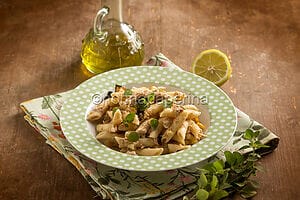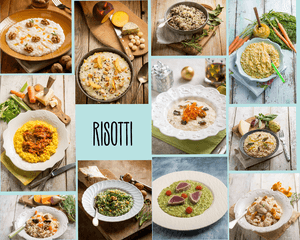Broad beans

The exceptional versatility of broad beans
This section discusses broad beans, a type of legume that Italian culinary traditions greatly value and consider extensively. By broad beans, we mean the seeds of the pods of the botanical species Vicia Faba, which often grows spontaneously in the countryside of the Mediterranean scrub. The pod appears flattened, elongated, and erect on the branches of the plant. This generally does not reach 2 meters in height.
Broad beans are valued for their substantial nutritional value, adaptability, and rich flavour. They are a great source of vitamins and mineral salts, especially iron and vitamin C. They are a wonder food for people with digestive issues because they are also high in fibre. Broad beans also contain levodopa, an amino acid that stimulates the brain’s production of dopamine. Lastly, they have a relatively low calorie intake, particularly when eaten fresh.
Ancient Egypt was already familiar with the broad bean, which is indigenous to Northern Africa. Currently, several varieties are grown, each having seeds that vary in size, colour, and shape. The most popular variety features large, flat, brown seeds that are also often found shelled. In Italy, the consumption of broad beans was notable until the beginning of the century, when it gradually declined. In southern Italy, dried broad beans are frequently eaten in soups with pasta or vegetables.
Even though the small-seeded type, called favino in our area, has the same chemical composition and nutritional value as the large-seeded species, it is more often used for feeding animals, notably horses.
There is currently a resurgence of interest in broad bean farming throughout the Mediterranean basin, with several initiatives aimed at enhancing the nutritional and agronomic qualities of the legume.
The consumption of broad beans, especially fresh ones, can cause favism, a form of anemia that occurs only in people with an inherited genetic predisposition (the deficiency of an enzyme in red blood cells). Favism is widespread in the Mediterranean basin, especially in Sardinia.
The different varieties and characteristics
Broad beans are almost all the same, which is why there aren’t many varieties reported, and the few we know of are quite similar. They differ, however, mainly in size. Here is an overview of the most consumed varieties.
- Paugyuga: It is a broad bean of Indian origin that is characterised by very small seeds. It is rarely cultivated; rather, it is harvested where it grows spontaneously.
- Minor beck: The seeds are only slightly smaller than average. The pod, however, is very small; in fact, it weighs 60% less than the pods of classic broad beans.
- Equine: It is a variety characterised by a slightly smaller pod than normal. Its main characteristic is its shape, which is rather elongated.
- Major Harz: This variety is characterised by its large dimensions. The pod can reach 1 kg in weight and can even be 30 cm long. Each pod contains up to 15 seeds.
How to incorporate them into recipes
Many regional culinary traditions heavily incorporate broad beans. They are prepared “a macco,” which entails a lengthy cooking process and a partial reduction into puree, in southern Italy, especially in Calabria and Sicily. These legumes can also be used in even more elaborate recipes, including wonderful risottos. I’ve included a small selection of the recipes in this section below.
The reference is to fettuccine, which is a seemingly straightforward first dish that may please both the tongue and the eyes. In addition, the broad bean salad is a highly satisfying, nutrient-dense, and organoleptically balanced side dish.
Almost anything from broad beans can be used! What am I referring to? I’d like to share a special recipe with you: risotto made with broad bean skins, peas, and potatoes. It is special because it is a bit of a symbol of what recovery cuisine allows us to do, but it also lends itself to an approach that aims for excellence, raw materials permitting.
We all know that selecting first-rate raw ingredients and top-notch goods is crucial to a recipe’s success. All of this will enable us to repurpose everything as effectively as possible without producing a lot of trash or needing to discard half of the refrigerator. This will allow us to use every component of a product and also reap the benefits of the nutrients found in the products we are going to discard.
Some delicious recipes involving broad beans
It is worth presenting some recipes involving broad beans, which will enhance this legume and bring a bit of liveliness to the kitchen.
Rice with broad beans and salmon: It is a different rice salad that combines autumn and summer flavours. The full-bodied and delicate flavour of the broad beans combines with the “fatty” and savoury hints of the salmon. The meal is enhanced with basil and tomatoes.
Pasta with prawns and broad beans. It is a very colorful first course that plays on seemingly daring combinations. In this dish, the full-bodied flavour of the broad beans enhances the delicacy of the prawns.
Fresh broad beans with eggs. It is a side dish that also serves as a second course, given the presence of eggs. The broad beans are peeled and cooked in a sauté of onions. After that, they have to be completed in a different pan with a fried egg placed in the middle.
Fresh broad bean pesto: It is an alternative to the classic Genoese pesto. There’s still plenty of basil, which brightens up a broad bean purée. It works well for creating sophisticated appetisers as well as a variety of pasta dishes.
What is the difference between dried broad beans and fresh broad beans?
When talking about broad beans, a doubt always arises as to whether to use dried or fresh broad beans. Obviously, we are talking about the same food, but in a completely different form.
The nutritional properties do not change, but the nutrients are more concentrated in dried beans due to the almost total absence of water. As far as flavour is concerned, there are some important differences. Dried broad beans, even when cooked, have a fuller and stronger flavour. The fresh ones, however, retain a certain sweetness and marked delicacy.
As far as processing is concerned, fresh broad beans can be consumed as they are, although they should be peeled (the peel is still edible). Dried broad beans, on the other hand, must be treated like any other legume; that is, they must be immersed in plenty of water and left to soak for several hours, preferably a whole night.
What are the benefits of broad beans?
As we have seen, the nutritional profile of broad beans is truly excellent, so it is worth examining the impact they have on the body. Here are some interesting properties that broad beans provide.
They aid in digestion: The reason for this lies in the abundance of fibre, which is present in both dry and fresh forms. This type of legume also helps to resolve minor constipation problems.
They help you lose weight: Fresh broad beans provide less than 90 kcal per 100 grammes, which is a very low value considering their nutritional completeness. Furthermore, they can also be used for low-calorie diets as they reduce hunger.
They help prevent cancer: Broad beans are rich in antioxidants, especially vitamin C. Antioxidants are substances that regulate the process of cellular regeneration, counteracting one of the most common mechanisms of cancer formation.
They strengthen the immune system: The abundant presence of vitamin C has an impact, which is not a prerogative of broad beans but of all plant foods.
They regulate bad cholesterol and blood sugar: Broad beans aid in lowering bad cholesterol and blood sugar, which are frequently to blame for acute and frequently fatal heart disease.
Who can’t eat broad beans?
As I previously stated, people with favism should not eat broad beans. In this instance, the effects of consuming broad beans can be hazardous and include fever, chills, nausea, vomiting, tachycardia, and even trouble breathing. Favism is a fairly widespread pathology that limits the consumption of broad beans.
Apart from this, broad beans don’t really have any severe contraindications, but like any other food, they should be consumed in moderation. Because of the high fibre content, excessive ingestion may cause some digestive issues. The latter may have a slight laxative effect, but it can also be a double-edged sword.
Those who, despite not suffering from favism, take monoamine oxidase inhibitor drugs, such as antidepressants, should instead limit their consumption of broad beans.




















